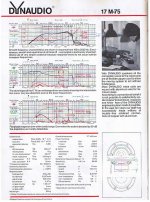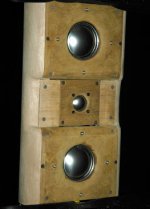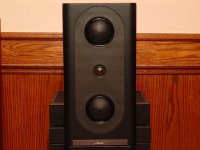I'm still reading the responses in this thread but wanted to add this to the conversation, because this company pioneered the use of a dome midrange, well, dome-equipped drivers period back in the 1950s* though the following was sold back in 1992**:
Acoustic Research Limited Model 3 brochure
Eleven photos of the Model 3, including its (large!) crossover
This system uses two 3" soft-dome mids crossed over at 300Hz. Bass is handled by one 12" driver in an acoustic-suspension enclosure and the rest of the audio spectrum by a 1" soft-dome tweeter.
FYI: it may seem that I'm living in the past by posting all these older loudspeakers, but I really don't. What I do believe in is having a good sense of history, and in this case being aware of what types of technology were used in the past. Partly because it's just interesting, to me anyway. But much more importantly, to make sure what we are doing NOW is truly an improvement on technology used previously. Sometimes in the race to move ahead, I think certain technologies are left behind simply because they are "old" but in reality they can still be useful and offer some advantages vs. the new stuff.
Forget the past and you're bound to repeat it - what a waste of money and time, eh?
* more info here concerning this speaker, which btw is featured in The Smithsonian Institution; pics of this quietly elegant loudsepaker can be found here
** three years before the company was basically destroyed, along with Advent, when Recoton Inc acquired them
Acoustic Research Limited Model 3 brochure
Eleven photos of the Model 3, including its (large!) crossover
This system uses two 3" soft-dome mids crossed over at 300Hz. Bass is handled by one 12" driver in an acoustic-suspension enclosure and the rest of the audio spectrum by a 1" soft-dome tweeter.
FYI: it may seem that I'm living in the past by posting all these older loudspeakers, but I really don't. What I do believe in is having a good sense of history, and in this case being aware of what types of technology were used in the past. Partly because it's just interesting, to me anyway. But much more importantly, to make sure what we are doing NOW is truly an improvement on technology used previously. Sometimes in the race to move ahead, I think certain technologies are left behind simply because they are "old" but in reality they can still be useful and offer some advantages vs. the new stuff.
Forget the past and you're bound to repeat it - what a waste of money and time, eh?
* more info here concerning this speaker, which btw is featured in The Smithsonian Institution; pics of this quietly elegant loudsepaker can be found here
** three years before the company was basically destroyed, along with Advent, when Recoton Inc acquired them
Last edited:
My Yamaha NS1000 loudspeakers have 3 inch mid domes (beryllium) covering 500Hz to 6k, that is about the whole presence range.
Over the years I collected some pairs of these mids (and tweeters) off Ebay.
I have yet to hear a better midrange!!
Electrostatic like transparency up to very high listening levels.
Over the years I collected some pairs of these mids (and tweeters) off Ebay.
I have yet to hear a better midrange!!
Electrostatic like transparency up to very high listening levels.
Err.... it seemed no one brought up the breakup issues.
Soft domes inevitably breakup above certain frequency. When they do so, the effective radiating area tends to be around the outer edge of the dome - near the voice coil. This is not good for HF dispersion, quite the opposite of that shape suggests.
By contrast, effective radiating area of the cone drivers shrinks when breakup.
Soft domes inevitably breakup above certain frequency. When they do so, the effective radiating area tends to be around the outer edge of the dome - near the voice coil. This is not good for HF dispersion, quite the opposite of that shape suggests.
By contrast, effective radiating area of the cone drivers shrinks when breakup.
my Dynaudio mid dome 7.1 system
center channel D'Appolito configuration
2 x Dynaudio 17w75 (variovent) + 2 x M560d + 1 x T330
700 and 3 khz crossover
fronts D'Appolito
4 x 24w75 + 2 x M560 + 1 x T330 per side
700 and 3 khz crossover
4 sides and rear dipoles 2 x 17w75 (variovent) +2 x D260 each cabinet
30w100 subs
MIT Film and foil crossovers, Caddock power film, foil inductors, MIT RTX tweeter caps
Powered by 7 channels Borbely Millenium - Blackgate N, Vishay bulk foils
While today I''d use a 5 or 6 inch mid I'm too fed up with speaker building to change and prefer to compare single malts while I suffer through the dome mids.
center channel D'Appolito configuration
2 x Dynaudio 17w75 (variovent) + 2 x M560d + 1 x T330
700 and 3 khz crossover
fronts D'Appolito
4 x 24w75 + 2 x M560 + 1 x T330 per side
700 and 3 khz crossover
4 sides and rear dipoles 2 x 17w75 (variovent) +2 x D260 each cabinet
30w100 subs
MIT Film and foil crossovers, Caddock power film, foil inductors, MIT RTX tweeter caps
Powered by 7 channels Borbely Millenium - Blackgate N, Vishay bulk foils
While today I''d use a 5 or 6 inch mid I'm too fed up with speaker building to change and prefer to compare single malts while I suffer through the dome mids.
Acoustic Research struggled with the dome midrange 3 way design for nearly two decades. Starting with AR3 where the 12" AS woofer crossed over to a 2" dome MR at 1Khz, the problem was at the upper end of the woofer. With AR3a, an improved MR dome crossed over to the same woofer at 575. The problem shifted to the lower end of the MR. AR 10 pi, 303, and similar had the same problem. With AR5, a smaller woofer matched up better with the MR dome but at the expense of the lowest few notes in the woofer. The problem was finally blown out of the water with Teledyne AR9 when an 8" LMR cone driver was added. The cabinet sized doubled and two side firing 12" woofers gave that speaker room shaking bass capability. Many who collect AR speakers feel it was the best one they ever made. So there in a nutshell is the problem, the low end limitations of a 2" dome but dispersion is excellent. BTW, Edgar Villchur founder of AR invended the dome driver.
BTW, Edgar Villchur founder of AR invended the dome driver.
Sid Hecht claimed that HE did.
HiVi TM1a (chamberless/'capped' DMN-a midrange):

Do you have a thread for that dome + (presumably) LAT-250 speaker? Looks interesting.
How high does the LAT-250 play?
Sid Hecht claimed that HE did.
A lot of people did. Some believe it was Fisher. But I think those familiar with the history of this industry agree with the "official credit" being given to AR. They also invented the Acoustic Suspension woofer (their original claim to fame) and ferrofluid cooling among other innovations. The dome tweeters introduced by AR and later even further improved by Roy Allison who spun his company off from AR have no modern paradigms. Their dispersion at high frequencies in both horizontal and vertical planes far exceeds anything available today. Current concepts basically reject the notion of very wide dispersion and so the dome geometries are different and they are usually inset in what could be considered a mini horn to further restrict dispersion. This beaming is claimed to improve imaging. This makes it very difficult or even impossible for anyone who wants to restore an old AR speaker to anything like original performance using a dome tweeter to find a suitable replacement. The Hi-Vi R-1 tweeter many recommend admittedly sounds different from the original and is a compormise. There are some good soft dome midranges offered by Morrel. Choose one with the lowest Fs available for best results.
Over here I do:
Drivers: Tymphany LAT250-004 (series)/HiVi TM1a (unchambered) - Techtalk Speaker Building, Audio, Video, and Electronics Customer Discussion Forum From Parts-Express.com
...and I have lotsa pictures here:
NEHD pictures by wolf_teeth_speaker - Photobucket
Personally, I think if you can notch out the LAT250 resonance at 1-1.1khz, you could run it almost up to that point. It's an odd driver, and has a planar-response off-axis pattern. Vertical dispersion is horrible in the way I have it mounted, but horizontal is very wide. Combined with dome mid and tweeter, the response off-axis is really well done. A trick for the LAT is to use a 3rd order electrical lowpass xover on it to make it happy. Due to the resonance and cliff that follows, it yields a steep 5th order acoustic rolloff. Combined with the mid and you get a quasi-4th order. The additional DCR of smaller wire diameter coils also helps damp its inherent bump in the bass response, so that is also advised, at the cost of a bit of attenuation.
It has a high Qts, which I could not model vented or aperiodic with much success and have a flat response outcome, so I ran it sealed. The other thing, is that the Vas is listed as 3-4 different specified values, and you can't even attempt Delta-mass to get a reading that way. Story short I made a guess about the volume, and came out getting response to about 50 Hz or so.
If you want a writeup, I have finally uploaded it to my blog:
"N.E.H.D.";Writeup transmission. Critical details will follow... - Techtalk Speaker Building, Audio, Video, and Electronics Customer Discussion Forum From Parts-Express.com
Let me know if you have any more questions,
Wolf
Drivers: Tymphany LAT250-004 (series)/HiVi TM1a (unchambered) - Techtalk Speaker Building, Audio, Video, and Electronics Customer Discussion Forum From Parts-Express.com
...and I have lotsa pictures here:
NEHD pictures by wolf_teeth_speaker - Photobucket
Personally, I think if you can notch out the LAT250 resonance at 1-1.1khz, you could run it almost up to that point. It's an odd driver, and has a planar-response off-axis pattern. Vertical dispersion is horrible in the way I have it mounted, but horizontal is very wide. Combined with dome mid and tweeter, the response off-axis is really well done. A trick for the LAT is to use a 3rd order electrical lowpass xover on it to make it happy. Due to the resonance and cliff that follows, it yields a steep 5th order acoustic rolloff. Combined with the mid and you get a quasi-4th order. The additional DCR of smaller wire diameter coils also helps damp its inherent bump in the bass response, so that is also advised, at the cost of a bit of attenuation.
It has a high Qts, which I could not model vented or aperiodic with much success and have a flat response outcome, so I ran it sealed. The other thing, is that the Vas is listed as 3-4 different specified values, and you can't even attempt Delta-mass to get a reading that way. Story short I made a guess about the volume, and came out getting response to about 50 Hz or so.
If you want a writeup, I have finally uploaded it to my blog:
"N.E.H.D.";Writeup transmission. Critical details will follow... - Techtalk Speaker Building, Audio, Video, and Electronics Customer Discussion Forum From Parts-Express.com
Let me know if you have any more questions,
Wolf
I think at least Infinity tried to address this issue with one of their larger domes - five inches(!) in this case - by using a grid-like system of carbon material applied to the dome: Kappa 8 and 9. BTW this dome was x'ed over at 80HzErr.... it seemed no one brought up the breakup issues.
Soft domes inevitably breakup above certain frequency. When they do so, the effective radiating area tends to be around the outer edge of the dome - near the voice coil. This is not good for HF dispersion, quite the opposite of that shape suggests.
By contrast, effective radiating area of the cone drivers shrinks when breakup.
Speaking of AR, I am surprised more present-day driver manufacturers don't offer a combined mid+tweeter assembly like AR did back in the day with the later models in their 9 Series (scroll down; AR9 library page is here).
Right now I see lots of tweeters offered with truncated mounting plates to make them easier to mount close to the other drivers on a baffle, so am not sure why the mid+tweeter option - whether or not a dome or cone is used for the mid frequencies - is hardly ever offered.
Right now I see lots of tweeters offered with truncated mounting plates to make them easier to mount close to the other drivers on a baffle, so am not sure why the mid+tweeter option - whether or not a dome or cone is used for the mid frequencies - is hardly ever offered.
Last edited:
By hand, for sure, but the hands holding some electric tools. Makes the things easy ! 
To go back on topic, this can be considered as medium domes. And to comment your post, the manufacturers know that this is a niche market with at the end a very expensive product. So, no future.
I know why my drivers acoustic centers are seemingly far from each other, it's because of the magnets. Could it be the same reason for the AR ? See the pic...

To go back on topic, this can be considered as medium domes. And to comment your post, the manufacturers know that this is a niche market with at the end a very expensive product. So, no future.
I know why my drivers acoustic centers are seemingly far from each other, it's because of the magnets. Could it be the same reason for the AR ? See the pic...
Attachments
Buy new neodymium drivers it will help a lot.I know why my drivers acoustic centers are seemingly far from each other, it's because of the magnets. Could it be the same reason for the AR ? See the pic...
That's the entire question!
Personally, I've never liked dome midranges. To me they are just over grown dome tweeters and just like most dome tweeters dome midranges are ring radiators also.
I prefer the sound of a small cone in the 4-5 inch category.
- Status
- This old topic is closed. If you want to reopen this topic, contact a moderator using the "Report Post" button.
- Home
- Loudspeakers
- Multi-Way
- Why aren't dome midranges more popular?



